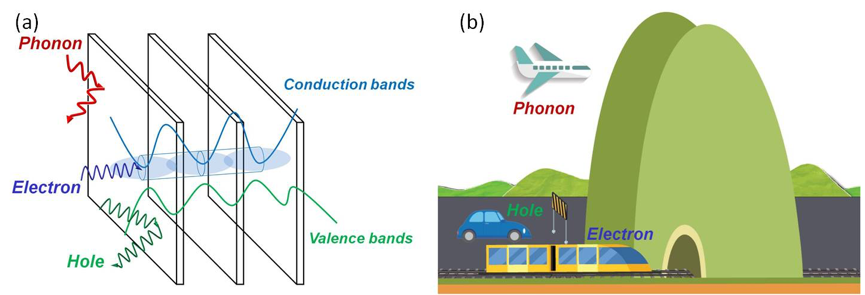Researchers make breakthrough in magnetic geometry-induced quantum geometry and nonlinear transport
2025-06-06SUSTech hosts IOP Forum with President of Institute of Physics Sir Keith Burnett
2025-03-26Researchers discover unusual thermal conductivity in high-symmetry single crystals
2025-03-26New efficient method detects quantum temporal correlations
2025-03-26Researchers explore unconventional magnons predicted by spin space groups
2025-03-25On May 18, an academic paper co-written by SUSTech's Department of Physics and Beihang University (previously known as Beijing University of Aeronautics and Astronautics) was published in the leading academic journal “Science.” Named “3D charge and 2D phonon transports leading to high out-of-plane ZT in n-type SnSe crystals”, the paper was also made possible by Tsinghua University, University of Hong Kong and Shanghai Synchrotron Radiation Facility, CAS Shanghai Institute of Applied Physics. SUSTech Physics Professor He Jiaqing and Beihang University Professor Zhao Lidong are the co-corresponding authors of this paper.
Thermoelectric conversion technology is a clean energy technology that uses semiconductors to convert electrical and thermal energy directly. The thermoelectric conversion efficiency of the core material has been restricting further development of this technology. In recent years, SnSe (tin selenide) single crystal materials have become a star in the field of thermoelectric materials because of its environmental protection, abundant reserves, low price, and excellent performance. An 2016 paper co-authored by Prof. He Jiaqing in the journal “Science” states that the use of an adjustable energy band structure to regulate the conductivity and thermoelectric emf of p-type SnSe enables its (p-type tin selenide’s) thermoelectric performance to achieve breakthroughs in the low-temperature region. After nearly two years of continuous in-depth research in this field, there has recently been a breakthrough in the thermoelectric properties of n-type SnSe.It was found that the two-dimensional interface of SnSe with a layered structure has a strong scattering effect on the phonons (Fig. 1 left), causing SnSe to have a very low thermal conductivity along the inter-layer direction and a minimum theoretical value at 773 K. ~ 0.18 W/mK. Finding low thermal conductivity materials and reducing thermal conductivity is an effective way to improve the ZT value of thermoelectricity in the field of thermoelectricity for a long time. On the basis of focusing on the low thermal conductivity between SnSe layers, high thermoelectric performance can be achieved if high electrical transmission performance can be achieved in this direction. By simplifying the binding of carrier concentration to the ZT value determined by Wiedemann-Franz and Pisarenko's relationship, the relationship of ZT value can be simplified as follows:
Therefore, improving the electric transmission performance between layers requires optimizing both the carrier mobility (μ) and effective Mass (m). Because of the phase transition from Pnma to Cmcm at 800K, the SnSe material undergoes synchrotron radiation and temperature-change TEM experiments, and it is found that the phase transition continuously occurs from 600K. Through this continuous phase transition property and adjusting the electron doping concentration, there will be a process of degenerate convergence (increasing the effective mass and reducing the mobility) and retracting degenerate convergence (reducing the effective mass and increasing the mobility) between the light-conducting band and the re-conduction band. By using this process, the product of the mobility and the effective mass (in Figure 1) is exactly optimized, so that SnSe maintains high electrical transmission performance over the entire temperature range. By comparing electron- and hole-doped n-type and p-type SnSe materials, it was found that the p-orbital of Sn and Se after electron doping generates electron delocalization at the bottom of the conduction band (but not at the valence band top). This phenomenon exists so that the charge density of the n-type SnSe is increased enough to fill the gaps between the layers and tunneling of the electrons between the layers is achieved (Fig. 1 right).

Figure 1. "Two-dimensional phonon/three-dimensional charge" transmission significantly improves the thermoelectric properties of n-type SnSe: interfacial scattering prevents ultra-low thermal conduction from phonon transmission; multi-conductor degeneration and ablation are optimized by continuous phase transformation The mobility and effective mass; large charge density makes electrons (n-type) easy to transport holes (p-type).
This phenomenon can be simply described as follows: the intrinsic layered structure of SnSe is like a wall and can simultaneously block the transmission of phonons and carriers (electrons and holes). However, after heavy-electron doping, the electronic delocalization at the bottom of the conduction band increases the charge density, and a tunnel for the transmission of electrons is tailored between the wall and the wall, as shown in Figure 2. On the basis of the large charge density, coupled with the continuous phase change caused by changes in the band structure and crystal symmetry of the three main factors make SnSe in the interlayer direction showed excellent electrical transmission performance when the temperature is higher than 700K. The inter-layer direction of SnSe produces a more superior "three-dimensional charge" transmission effect than within the layer. This "two-dimensional phonon/three-dimensional charge" transmission characteristic greatly improves the thermoelectric properties of n-type SnSe.

Figure 2. “Two-dimensional phonon/three-dimensional charge” transmission diagram: (a) Electrons at the bottom of the conduction band create delocalized hybridization, increasing the charge density, providing channels for electrons to travel between layers, and phonons and holes receiving Layers are blocked at the interface; (b) Aircraft (phonons) that are not subject to orbital constraints are blocked by mountains (layer interfaces), trains (electrons) can cross tunnels, and cars (holes) cannot cross tunnels due to mismatched orbits.
Physics Department has made important contributions to this work. Assistant Professor Huang Li and Postdoctoral Researcher Wu Minghui provided theoretical calculations and explained the mechanism of related performance improvement. Engineer He Dongsheng used situ temperature-change transmission electron microscope (TEM) technology to directly observe the structural changes in materials as temperature varied. Associate Professor Wang Kedong and Postdoctoral Researcher Wu Xuefeng measured the charge density distribution with a scanning tunneling microscope. The work was supported by the in-situ TEM technology of SUSTech Pico Center, Major Cultivating Project of Guangdong Natural Science Foundation, funding from the Shenzhen Peacock team.
Article link: http://science.sciencemag.org/content/360/6390/778
Professor He Jiaqing's research group link: http://jqhphy.sustc.edu.cn/